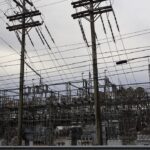Energy News Beat
The following commentary was written by Shelley Hudson Robbins, Project Director at the Clean Energy Group. See our commentary guidelines for more information.
The North Carolina Utilities Commission just dropped a riveting order outlining the nightmare scenario that played out in control rooms and meeting rooms one year ago as Duke Energy struggled to keep a stable grid in the midst of Winter Storm Elliott. The December 2022 storm coincided with a collection of unexpected power plant failures, gas pipeline capacity and energy imports that failed to show up, and internal circuit controls that failed. It is hard to imagine a large section of our East Coast power grid going down. But we were close. The heroes of the story are only mentioned in a footnote: the line workers and field personnel who scrambled to their posts on what should have been a holiday weekend with family to figure out workarounds, manually turning circuits off and on to shed enough load to match available supply with a hobbled generation fleet.
The order includes a striking fact: Duke Energy’s fleet of options included almost no demand side resources. During the storm, Duke Energy Progress (DEP) and Duke Energy Carolinas (DEC) only called upon 200 megawatts of demand response each. Compared to the distributed load curtailment resources that are available to neighboring grid operator PJM, which includes 13 states plus the District of Columbia, this seems surprisingly small.
PJM has more than 30 curtailment service providers (CSPs), and over 2 million commercial and residential customers participate as load management resources, with an installed load management capacity of 7,699 megawatts in 2022-2023. Fifty-three percent of these resources were able to respond within 30 minutes. The CSPs actually delivered just shy of 10,000 megawatts of load reduction between 2 and 4pm on December 24. As PJM reported in its September 2023 Load Management Report, demand response resources “over-performed” during the Winter Storm Elliott event.
PJM’s December 24, 2022 peak load was 136,000 megawatts, according to the grid operator’s report on the Winter Storm Elliott event released last July. PJM, like Duke, was in crisis management mode during the winter storm, but ultimately the grid operator was not forced to shed load.
Get connected
Every morning, thousands of energy professionals turn to our newsletters for the day’s most important news. Sign up for free to get the latest delivered straight to your inbox.
DEP’s peak load on the morning of December 24 was 14,840 megawatts, and DEC’s peak load at roughly the same time was 21,768 megawatts, for a combined peak load of 36,608 megawatts. DEP was forced to shed 800 megawatts of load by turning circuits off and back on, and DEC was forced to shed 1,000 megawatts. Duke Energy’s combined peak load during Winter Storm Elliott is the equivalent of about 27 percent of PJM’s peak load during the storm. If Duke Energy had a proportionate amount of demand response capacity (PJM had 10,000 megawatts), that would have provided at least 2,700 megawatts of capacity to call upon. But Duke did not have this resource and instead, the utility shed 1,800 megawatts by turning circuits off and then back on, cutting power for hours to customers in North Carolina. Could demand response – if it were in place in DEP and DEC – have prevented the blackouts that endangered vulnerable customers on Christmas Eve? The math says yes.
In its December 22 order, the NCUC did not recommend that Duke Energy develop a more robust demand response program, even though these programs have proven to be cost effective and reliable. In PJM, fossil resources were not reliable during Winter Storm Elliott, but demand response “over-performed.” Instead, the Commission focused on improved load forecasting, avoiding planned outages in December, winterizing the fleet, improving gas-electric interdependencies, and it required Duke to file reports on just about everything except demand response.
Distributed demand response can take many forms, including aggregated behind-the-meter battery storage and aggregated control of heating loads, water heating, and EV charging. Participants in aggregated DR programs are compensated for performance, a feature that can help ease energy burden. Aggregation of these resources has proven valuable to capacity markets in parts of the country that have grid operators making decisions about dispatchable assets rather than monopoly utilities making those decisions. Further, Winter Storm Elliott demonstrated that aggregated demand response resources are reliable during winter peak demand when fossil resources fail for a myriad of reasons. This level of reliability should be reflected in how utilities incentivize these resources.
Duke Energy’s North Carolina utilities are required to achieve carbon reduction goals established by the state legislature in House Bill 951. Clean Energy Group filed its December 2023 report Distributed Energy Storage: The Missing Piece in North Carolina’s Decarbonization Efforts, prepared by Applied Economics Clinic, in the Duke Energy Carbon Plan Integrated Resource Plan comments docket as a way to launch the discussion by providing policymakers and advocates the information they need to harness the full potential of distributed battery storage as a demand response tool. Development of a robust portfolio of demand side resources in North Carolina will be a crucial element of meeting the challenges associated with load growth while simultaneously achieving the goals set forth in the North Carolina Carbon Plan.
The post Commentary: Demand response could have prevented blackouts in North Carolina appeared first on Energy News Beat.








